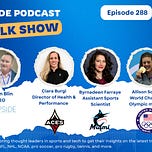Today as part of our continued effort to bring more awareness on female athletes, teams and associated trends related to female athletes, we have the honor to interview a group of female sports performance experts:
Allison Schmitt, a 10 time Olympic medalist and multiple world champion in swimming (Team USA), and consultant with Orreco a leading sports data company.
Ciara Burgi, Director of health and performance, Las Vegas Aces (WNBA).
Byrnadeen Farraye, assistant sports scientist, Miami Marlins (MLB).
Here are the topics and questions that we covered on the group podcast:
The next frontier in women’s performance — emerging areas such as data, recovery, health tracking, and leadership development.
Key skills and mindsets needed for the next generation of practitioners in women’s sports.
Redesigning performance models and AI tools to be built specifically for women rather than adapted from male baselines.
The future vision for female athletes by 2030 — scientific, cultural, and economic advancements.
You can watch the video interview below by clicking on the Youtube link. You can also listen to the audio interview by clicking on the link at the top of the page:
Here are the quotes from the interview with Ciara, Allyson and Byrnadeen:
Q1. What’s the next big frontier for women’s performance — data, recovery, health tracking, or maybe something cultural like leadership development?
Allison Schmitt:
“From an athlete’s perspective, I think the next big frontier is really understanding our bodies in real time — not just tracking data but actually applying it. For so long we’ve trained off systems that were built for men, and now we’re finally connecting the dots between the science, the cycles, the recovery, and the performance. Working with FitrWoman, we’ve taken something that used to feel like a mystery and turned it into something empowering. We’re realizing that feeling right — understanding hormonal shifts and personalizing recovery — isn’t an ‘extra,’ it’s essential for performance. And I think the next step is making that part of every team’s language. It’s not just a ‘female-specific’ conversation anymore; it’s just really smart performance that benefits everyone.”
Byrnadeen Farraye:
“I think we’re still playing a lot of catch-up. Historically, women weren’t even allowed to participate in strength training — for a long time, it was seen as something women shouldn’t do. Even in baseball, where I work now, strength training for men is still fairly new. So when you think about how far behind we’ve been culturally and historically, it makes sense that women’s performance science is still evolving. I think the next frontier is about being smarter — not necessarily doing more, but training smarter, recovering smarter, and really understanding how to make the most of the data and technology we have now. We’re bridging the gap between history and modern performance.”
Ciara Burgi:
“I agree with both of them, and I’d add that from a structural standpoint, not every women’s team even has its own facility — which is wild. You can’t build a true high-performance culture without basic infrastructure. In the WNBA, we’re just starting to see teams like the Las Vegas Aces set the standard by building their own facilities, but others are still far from that. Having a full-time staff, your own space, your own recovery setup — that should be the baseline, not the exception. At the same time, because women’s sports don’t have the same legacy systems that men’s sports do, there’s a kind of freedom and creativity that comes with that. Men’s sports have history — which is great, but it can also be a limitation. In women’s sports, we have the chance to build something different, more collaborative, and more forward-thinking from the ground up.”
Q2. When you think about the next generation of practitioners entering women’s sports, what skills or mindsets do they need most?
Byrnadeen Farraye:
“We need better practitioners across the board — whether it’s men’s or women’s sports. I think we’ve been asking the same questions since the 1960s in both research and clinical settings. The next generation of practitioners has to be critical thinkers — people who know how to ask better questions and not just accept old assumptions as fact. We need coaches, trainers, and scientists who understand empathy, who know where their athletes are coming from, and who can connect with them as human beings. You can have all the technology in the world, but if you don’t understand the human in front of you, you won’t be effective. For women in particular, it’s about recognizing that the environment they’ve had access to — or sometimes haven’t had access to — shapes everything about their experience in sport.”
Ciara Burgi:
“There’s nothing you can look up about how to connect with other human beings. That’s the foundation of being successful in any performance environment. You can Google the answer to any question about physiology or training, but if you can’t connect with people, if you can’t read the room or sense when someone needs space versus when they need support, it doesn’t matter what you know. We work in human systems, not mechanical ones. Practitioners have to learn to read people — some athletes want you to hover and coach them through every rep, others want you to hand them the program and step back. If you can’t read that and adapt, you won’t get buy-in. Everything we do starts and ends with human connection.”
Allison Schmitt:
“The two words that immediately come to mind for me are curiosity and empathy. Athletes don’t need someone who just reads numbers off a screen — they need people who see them as whole individuals, not just data points. And practitioners have to be comfortable in the gray areas because so much about performance, especially female performance, is still evolving. Having the humility to say, ‘We don’t fully know yet, but let’s learn together,’ builds trust. And that trust is what makes the science work for the athlete, not just at them. I went back after my last Olympics and got my master’s in social work because connection and understanding are at the heart of performance. With all the tech we have now, we can’t lose our human ability to connect.”
Q3. Much of the data and systems in sport are built on male baselines. How do we start designing performance models and AI tools that are truly built for women, not adapted from men?
Allison Schmitt:
“We have to start by accepting that ‘normal’ looks different for each of us. If we can use AI and performance tech to understand those individual baselines — hormonal cycles, recovery rates, life stages, injuries, even vitamins or nutrition — we can make the data more accurate and more personal. The goal isn’t to overcomplicate things but to make them truly representative. You can’t just shrink a men’s jersey and call it a women’s fit — and the same logic applies to data models and performance systems. They have to start with real female athletes, with our data, our voices, and our experiences at the center.”
Byrnadeen Farraye:
“I think it all starts with asking better questions — especially when it comes to AI. If we’re feeding AI only with data built from men, that’s all it’s going to learn. So we have to be very careful about the data we input and the questions we use to shape those systems. Representation matters — we need women in research, in tech, in sports science labs, and in leadership. When I worked in research on ACL injuries, which are far more common in women, we made a point to over-represent female subjects in our studies to help shift the baseline. It’s not just about adding women into existing models — it’s about building those models from the ground up to reflect women’s physiology and experiences.”
Ciara Burgi:
“We have to be okay with not knowing everything yet. There are real biological and hormonal differences between men and women, but we don’t fully understand all of them. So our job right now is to ask better questions, collect high-quality data, and lean into that discomfort of uncertainty. It might take 10 or 20 years for us to fully map what those differences mean for training and recovery, but we have to start by being curious and honest about what we don’t know.”
Q4. If we meet again in 2030, what do you hope will be different for female athletes — scientifically, culturally, or economically?
Ciara Burgi:
“By 2030, I hope there’s true equality in facilities, access, and resources — that every women’s team has its own space, full-time staff, and support systems as the baseline, not the goal. But more than that, I hope women’s sports become the model for how organizations are run. Because there’s less legacy, we have the opportunity to design new systems of leadership and collaboration. I’d love to see female-led organizations become the blueprint for what modern performance and leadership can look like — interdisciplinary, creative, and genuinely collaborative, not just using those words as buzzwords.”
Allison Schmitt:
“Scientifically, I hope that by 2030 we’re no longer having to explain why female-specific data matters — it’ll just be part of the language. Every athlete, male or female, should have access to tools that help them understand their bodies from adolescence through postpartum and beyond. Culturally, I hope it’s completely normal to talk about things like hormones, periods, and energy levels in the same way we talk about nutrition and training. And economically, I want to see investment that truly reflects the value women bring to sport — from research to staffing to sponsorship. We’ve already seen what happens when women’s sports are supported: the performance rises, the fan base grows, and the entire ecosystem benefits.”
Byrnadeen Farraye:
“All of those things — science, culture, economics — are intertwined. To advance the science, we need more funding. To get more funding, we need to keep proving the value and impact of women’s sports. And to do that, we need people to keep investing, researching, and supporting. I hope that in 2030, we’re not having to justify why women’s performance matters — it’s just part of the conversation. At the end of the day, I just want women to keep showing what we can do, because we already know we can do everything men can — and often better. We just need the same opportunities and resources to keep proving it.”
You may also like:
🔥Upside Chat with Female Sports Experts: Allison Schmitt (Olympic Champion),Mélanie Pauli (Swiss Football), Dr Christy Fernandez-Cull, PhD, CEO (DaVinci Wearables)
Today as part of our continued effort to bring more awareness on female athletes, teams and associated trends related to female athletes, we have the honor to interview a group of female sports performance experts:
🔥Upside Chat with Female Sports Experts: Andrea Hudy (UCONN), Megan Rottler Hattori (Duke University), Christy Fernandez-Cull (DaVinci Wearables), Shavini Fernando (OxiWear)
Today as part of our continued effort to bring more awareness on female athletes, teams and associated trends related to female athletes, we have the honor to interview a group of female sports performance experts:













